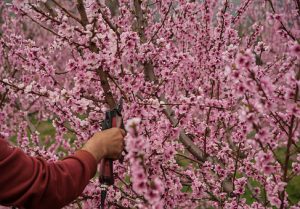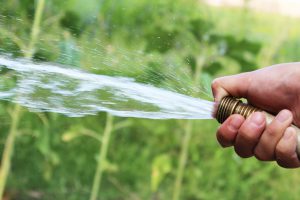
There are a lot of lawns that have plenty of trees that provide shaded areas on their lawn. This isn’t always a bad thing if you have your landscaping set up for a shaded area. But if it is just the grass shade is surrounds, it may cause that area to be thin.
This is simply because it is not getting what is needed to keep it as healthy as the rest of the lawn. How to deal with grass in shaded areas will be discussed in this post.
Steps to Assist Your Grass In Shaded Areas
 Pruning Trees – Pruning back the trees will help in removing some of the shade in the particular area. You can prune back the lower part of the tree, which will help a little bit. Try not to prune more than you need to by standing on the ground and pruning only what you can reach. If the tree is very mature, I would suggest consulting with an arborist before doing so.
Pruning Trees – Pruning back the trees will help in removing some of the shade in the particular area. You can prune back the lower part of the tree, which will help a little bit. Try not to prune more than you need to by standing on the ground and pruning only what you can reach. If the tree is very mature, I would suggest consulting with an arborist before doing so.- Aeration – We have discussed what aeration will do in in another post to make it easier for water, fertilizer, and air to reach the roots. It is best to do this before your grass reaches the time of its peak growing stage. Warm-season grass should be done in late Spring, while cool-season grass should be done in early fall.
- Add Compost – The grass in shaded areas doesn’t need as much fertilizer as the rest of the lawn. But what will help is to put a thin layer of compost on it in early spring. Do this after aerating if you decide to aerate the area. Also, if you plan to overseed, make sure you put compost down over it. You should still be able to see grass after covering with compost. Then spread it out with the back of a rake.
- Proper Seeding – The type of seed you use is helpful in shaded areas. Most turf grasses need 4 hours of direct sunlight. Because of this specialized shade-tolerant grass is available that is designed to thrive in partially shaded areas. Cool season shade-tolerant grass would be rye, fine & tall fescue, while warm season would be Zoysia & St. Augustine.
 Watering – Shaded area grass doesn’t use water as fast as the direct sun does. So this will call for cutting back on how frequently you water the area. Because of the trees, the grass roots compete with the tree roots for the water that is there. Also, the trees may block a lot of water in that area during rainfall, which the soil needs. So this will call for watering deeply and less frequently to even it out.
Watering – Shaded area grass doesn’t use water as fast as the direct sun does. So this will call for cutting back on how frequently you water the area. Because of the trees, the grass roots compete with the tree roots for the water that is there. Also, the trees may block a lot of water in that area during rainfall, which the soil needs. So this will call for watering deeply and less frequently to even it out.- Cutting – When you cut the lawn, you want to cut it a little differently from the rest of the lawn. For shaded areas, you want to cut it 1/2 inch to an inch taller than the rest. What this does is give the blades a better chance at photosynthesis, which is the process that fuels the growth. Whatever you do, don’t scalp this area because it rarely recovers.
- Fertilizing – You don’t have to fertilize as much as you would the sunny areas. It is recommended to give 1/2 to 2/3 less nitrogen per year, on the measure of 1 pound per 1000 sq. ft., and in cold weather regions, apply winterizer fertilizer at half of its recommendation.
- Fighting Weeds – If there are weeds present, you want to pull them out by the root or spot-spray them. The grass is already deprived of sunlight, and the herbicides can be stressful to the grass.
I hope the information in this post will help you deal with your shaded area grass, if you have any at all.
Thank you for visiting & please leave any comments or questions in the comment area. If you like receiving these tips, please sign up to receive this information as it is published.
You can also get your tools and products at the top header by clicking on Old School Lawn Store there or right here. Both are powered by Amazon, where the prices are competitive.
